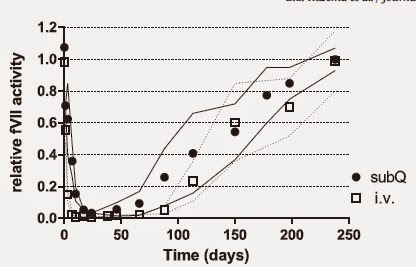Arrowhead Publishes SubQ Delivery Technology to Go Beyond the Liver

In late 2012, Arrowhead Research shocked the Oligonucleotide Therapeutics world when it presented spectacularly potent and prolonged gene knockdown data in non-human primates using a subcutaneously administered single-molecule Dynamic Polymer Conjugate (DPC) formulation. This arguably represented the most elegant delivery technology at the time. Moreover, also due to its small, but not too small size (10-20nm) and slight negative charge, it provided us with a glimpse into the future of systemic RNAi delivery for regulating genes beyond the liver.
It certainly got my full attention and made me invest almost 100% of my stock portfolio back then.
Unfortunately, despite the validation in non-human primates which suggested clinical readiness would not be far off, the subQ DPC technology has seemingly struggled to reach clinical/commercial maturity. Not only Arrowhead’s lead development candidate, ARC520 for HBV, but also its second development candidate, ARC-AAT for AAT-related liver disease, was still based on the intravenously administered two molecule DPC version. Although the reasons for the delays were never really disclosed, a few comments here and there made it seem very likely that chemistry and manufacturing issues were behind the delay.
Back to the Future
Last week, Arrowhead Research finally published a paper showing that single molecule DPC is still alive and kicking ( Rozema et al.2015) and is progressing towards clinical application. In essence, the new single-molecule subQ DPC prototype comprises of a membrane-active polymer which has been masked from premature cytotoxic interactions by pegylation and cell-targeting ligands that are added via protease-sensitive bonds; as before, the highly modified/stabilized RNAi triggers are appended by disulfide chemistry.
The DPC is made in a 4-step process followed by a purification step to remove unwanted side-products and reactants. The latter step is apparently important when going into primates.
The new old DPCs are thus distinguished from the intravenous version not only in that it combines the RNAi trigger and endolysosomal release polymer in a single molecule, but most importantly by the nature of its triggered release mechanism. Whereas in the former DPC generations triggered release was dependent on changes in pH such as they occur when a DPC is endosomally taken up, they are now responsive to the presence of certain proteases in lysosomes.
pH-dependent formulations apparently suffered from instabilities both in the body and during storage. This was adequate for targeting genes in the liver because of the ready access of macromolecules in the circulation to this organ following intravenous administration, but not when the DPC first has to reach the circulation from the subcutaneous space and when less well accessible target organs are the ultimate destination.
Accordingly, non-liver single-molecule DPCs of the latest publication had impressive circulation half-times of the intact, protected molecule of 11 hours. Similarly, such DPCs are stable for at least a year both in solution and when lyophilized.
The extra-hepatic potential thus facilitated by increased stability now needs to be demonstrated by finding suitable targeting ligands and I’m sure Arrowhead has been busy working on that. It should be noted that for target tissues where high concentrations comparable to the liver are unlikely to be achieved following systemic delivery, the extra kick that comes from an explicit release chemistry could provide a critical advantage over competing approaches. These include simple conjugates of the GalNAc-type and probably also self-delivering RNAi trigger chemistries which incorporate ‘milder’ release chemistries (like lipid tails).
Knockdown lasting for weeks and months

The most impressive demonstration of the single molecule DPC performance in the Rozema paper came from the primate studies. Here, a single administration of 0.5mg/kg 2’-O-methyl/F-modified RNAi trigger led to a highly potent knockdown (peak knockdown >95%) of liver expressed Factor VII with >80% knockdown of 2 and 4 months following subcutaneous and intravenous administration, respectively.
Following the 2012 delays and some uncertainties around what was really new and old in the recent publication, I am somewhat hesitant to declare that subQ DPC is now fully de-risked and ready-to-go. In that regard, it would be helpful to learn more about the tox profile of the new molecules and related to that which polymers will be eventually used (e.g. 2-molecule with melittin-like peptide, a polyacrylate in the publication).
Nevertheless, since Arrowhead has said that the new 2015 development candidate may be from the subQ line of DPCs (or if not going after a extra-hepatic target) one would think that the most important challenges have now been overcome.
Posted by Dirk Haussecker at Sunday, May 03, 2015
rnaitherapeutics.blogspot.com |






